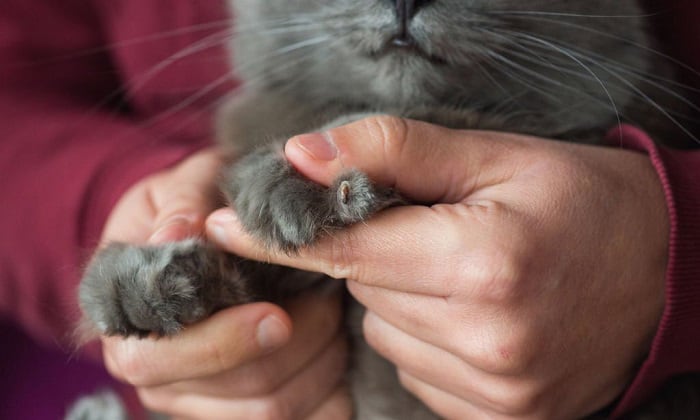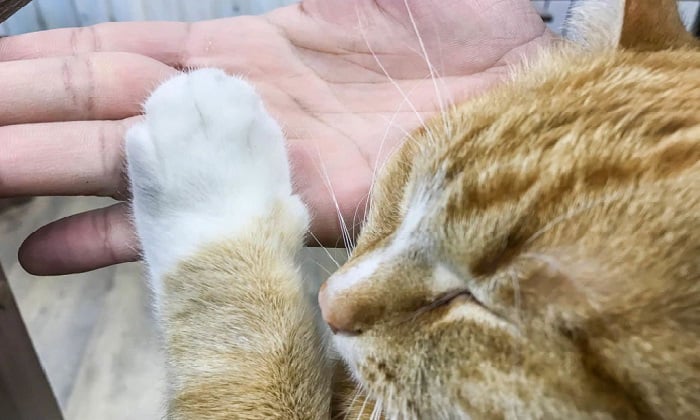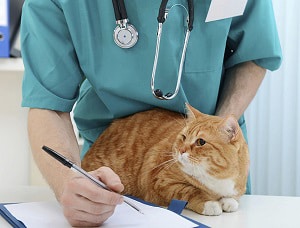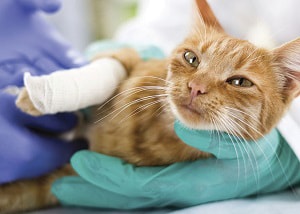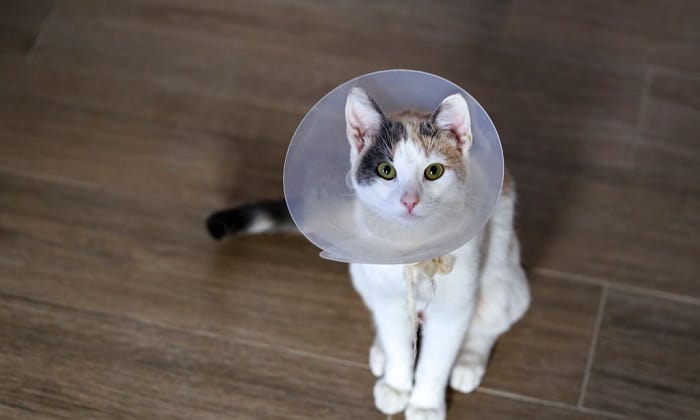If you’ve questioned “Why is my cat limping”, there’re some possible explanations. They might be suffering from a broken bone or a sprain or their nails become ingrown.
No matter the reason, any cat who’s limping is suffering from pain. However, they’re not showing it to you since it’s their instinct to hide the pain from their predators.
Though some minor injuries might be cured at home, you’d better take your cat to the vet to find the right cause and take appropriate treatment.
To ensure that there’ll be no worse issues, see our collective information below to find out what’s behind your cats’ discomfort and learn how to provide them with the care they need.
Table of Contents
What Causes Your Cat Limping
If you’ve noticed that your cat’s suddenly limping (either on his front or back legs), here are some potential reasons:
- A sprained leg, a broken bone, or joint dislocation (after a fall, wrong landing, or any unfortunate accident)
- There’s a small object stuck in his paw (like a thorn, burr, shard, or gravel)
- Arthritis (a painful disease in cat’s joints, more likely with old cats)
- His nail is torn, infected, or grown into his paw
- Being stung by a poisonous insect or bitten by an animal
- His paw pad is burnt (when it touches something hot like a stove or charcoal)
- Osteosarcoma (common bone cancer in cats)
What to Do if Your Cat is Limping
Once you’ve identified your cat’s back leg is weak or he has any signs of lameness, it’s time for a quick and gentle examination.
All you need to do is calm him first and then slowly move your fingers on his toes, pad, and limb to see whether there are any foreign materials, redness, and open wound. If you’ve found something unusual, note that area and compare it to his other legs for further observations and cure.
Notice that since your cat’s in pain, he might become much angrier and bite or scratch you. So be careful and stop the identification if he resists it too hard.
After this step, there are two circumstances that you need to consider:
1. For cases that can be cured at-home
If a shard or thorn is the reason for your cat limping front paw, use a tweezer to remove it and wash its leg carefully with salt water and antibacterial soap to clean the injured area and prevent any infection.
If that’s the case of an ingrown or torn nail, have it trimmed gently (like you usually do).
For sprains or bruises, use an icepack to improve the painful area (twice a day, 15 minutes each).
These potential solutions might work for your cat’s condition. However, it’s crucial to keep an eye on the cat’s limping front leg or back leg as well as his overall health to assure that your cure is on the right path and he’s gradually back to his normal walking.
If there’s still no clear improvement, contact your vet immediately to take the appropriate treatment.
2. For unidentified or more severe cases
For the remaining causes, it’s hard to tell why your cat’s limping unless you’re a veterinarian. Thus, making an appointment to take him to the hospital so that he can be examined and diagnosed exactly.
During the waiting time, restrict his movement to prevent any worse injuries. Plus, give him a comfy bed and a warm, clean environment to stay.
How to treat
Depending on your cat’s limping causes and health conditions, the vet will suggest suitable treatment to help him cured and have a good life after that.
Here are some possible treatments that might be applied:
1. Medications
If your cat has a problem with his joint condition (like arthritis), he’ll be given a medical treatment to help relieve his pain and care for his joint health.
Besides, there’ll be some extra drugs to help prevent infections, reduce levels of inflammation, and improve his immune system.
2. Surgery
When your cat’s leg is broken, he might need surgery. The surgical plates and pins will be used to repair his fracture, promote its healing time, and help him walk normally as quickly as possible.
However, not all the cats with the broken bone are put on the operation table. There are still cases that only need the use of the cast and splint to support the bone and ensure a good healing process.
3. Therapy
There are several types of therapies that can be used as a treatment for a kitten limping front leg or a cat limping back leg.
The first one is physical therapies which involve efficient techniques that are perfect for pain relief and wound healing as well as for improving cats’ mobility and flexibility.
Additionally, vets might apply some complementary therapies to deal with a limping feline’s pain. They include laser therapy, acupuncture, chiropractic care, massage, the use of supplements (such as CBD and Omega acids), and more.
The hardest treatment is when cats are diagnosed with bone cancer. They might suffer from the discomfort of radiation therapy or chemotherapy.
Should I bring my cat to the vet?
Some experienced owners might know a proper way to deal with a cat with simple lameness. However, to receive a complete diagnosis and suitable treatment (or some helpful advice) as well as rule out any potential illness (like infection), bringing him to the hospital is the optimal option.
Any of the following behaviors and situations happening to your cat calls for emergency care:
- The situation lasts for more than one day.
- You’ve examined it yet still have no idea about the cause.
- The appearance of swelling or open wounds (like punctures or cuts). In case it keeps bleeding, call the veterinarian right away.
- The limp appears to dangle in an awkward position.
- There’s caterwauling in your cat since he’s in so much pain.
Frequently Asked Questions
Why is my cat limping but not crying?
Many cat owners might wonder why their cats are limping but not in pain. This is only explained by their common habit of not showing pain and discomfort. This basic instinct is for protecting them from other dangerous animals.
Thus, don’t take it for granted that your cat’s not suffering from pain since he doesn’t display it. Proper care and treatment are still necessary.
Why is my cat limping but still jumping and running?
If you’ve found that your feline is limping front legs but still playing, it doesn’t mean he’s not in pain. You might expect your cat won’t put weight on the front paw but he still does and acts as if nothing happens.
As we’ve stated earlier, cats will become vulnerable in their predators’ eyes if they’re showing discomfort. Thus, the best way to prevent themselves from being at others’ dinners is to keep walking and jumping like normal.
A cat is limping and sleeping a lot. Should we be concerned?
Cats often sleep a lot. However, cats in pain might suffer from a bit of stress and sleeplessness. Thus, if your kitten still retains this habit when having a limping leg, it’s best to make an appointment with your vet to ask for advice and treatment.
Conclusion
If one day you’ve realized your cat is suddenly limping his back leg, we hope this informative article “Why is my cat limping” might help. Follow our guide to make sure that the problem is pinpointed and find an appropriate way for the first-aids as well as the treatment.
Cats can’t be at their usual active and energetic status unless their four legs are all in good condition. Thus, don’t neglect any minor injuries or changes, and take your cats to the hospital to prevent their pain and damage from getting worse.
Read more: Reasons why my cat shaking or throwing up undigested food.

I am Amy Sawy, a Doctor of Veterinary Medicine (DVM) graduate from the University of Kansas. y husband, Dr. Plummer, and I own a veterinary clinic in Phillipsburg, Kansas. In addition to my professional background, I am a devoted pet owner myself, with a household that includes dogs, rodents, and most notably, cats – a total of five felines in my home.
In 2020, I joined an organization as a professional writer, leveraging my experience and collaborating with my team to deliver the most valuable information for your cat’s care.



